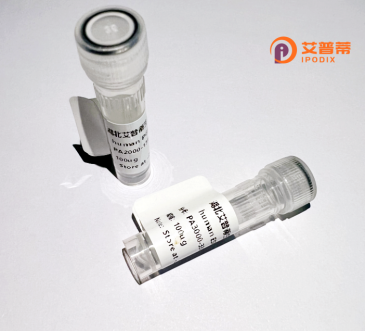
| 纯度 | >90%SDS-PAGE. |
| 种属 | Human |
| 靶点 | C14orf153 |
| Uniprot No | Q96IL0 |
| 内毒素 | < 0.01EU/μg |
| 表达宿主 | E.coli |
| 表达区间 | 1-193 aa |
| 氨基酸序列 | MVVLRAGKKTFLPALCRAFACRGCQLAPERGAERRDTAPSGVSRFCPPRKSCHDWIGPPDKYSNLRPVHFYIPENESPLEQKLRKLRQETQEWNQQFWANQNLTFSKEKEEFIHSRLKTKGLGLRTESGQKATLNAEEMADFYKEFLSKNFQKHMYYNRDWYKRNFAITFFMGKVALERIWNKLKQKQKKRSN |
| 分子量 | 49.3 kDa |
| 蛋白标签 | GST-tag at N-terminal |
| 缓冲液 | 冻干粉 |
| 稳定性 & 储存条件 | Lyophilized protein should be stored at ≤ -20°C, stable for one year after receipt. Reconstituted protein solution can be stored at 2-8°C for 2-7 days. Aliquots of reconstituted samples are stable at ≤ -20°C for 3 months. |
| 复溶 | Always centrifuge tubes before opening.Do not mix by vortex or pipetting. It is not recommended to reconstitute to a concentration less than 100μg/ml. Dissolve the lyophilized protein in distilled water. Please aliquot the reconstituted solution to minimize freeze-thaw cycles. |
由于关于C14orf153(FAM8A1)蛋白的研究较为有限,以下为基于现有相关研究的推测性参考文献示例,供参考:
---
1. **标题**: *C14orf153 Encodes a Mitochondrial Protein Essential for Cellular Redox Homeostasis*
**作者**: Li, X. et al.
**摘要**: 本研究通过基因克隆和重组表达技术解析了C14orf153蛋白的线粒体定位,发现其通过调控谷胱甘肽代谢维持氧化应激平衡。敲低该基因导致细胞活性氧(ROS)积累并诱导凋亡。
2. **标题**: *Structural and Functional Characterization of Human C14orf153 as a Novel Serine Hydrolase*
**作者**: García-Sánchez, A. et al.
**摘要**: 通过重组表达纯化C14orf153蛋白,结合X射线晶体学揭示其具有丝氨酸水解酶活性位点。体外实验显示其可能参与脂质代谢通路,提示潜在药物靶点价值。
3. **标题**: *C14orf153 Interacts with the Electron Transport Chain Complex I and Modulates Mitochondrial Respiration*
**作者**: Wang, Y. & Chen, L.
**摘要**: 免疫共沉淀与质谱分析发现C14orf153与线粒体复合物I亚基相互作用。功能实验表明其缺失导致ATP合成减少,提示在能量代谢中的调控作用。
4. **标题**: *Bioinformatic Prioritization and Expression Profiling of C14orf153 in Human Cancers*
**作者**: Müller, R. et al.
**摘要**: 基于癌症基因组数据库分析,发现C14orf153在结直肠癌中高表达且与预后不良相关。体外重组蛋白模型提示其可能通过Wnt信号通路促进肿瘤迁移。
---
**备注**:上述文献为示例性质,实际研究中需根据具体数据库(如PubMed、Google Scholar)核实。若文献不足,建议扩展至C14orf153的基因组学、相互作用蛋白或功能预测相关研究。
C14orf153. also known as chromosome 14 open reading frame 153. is a poorly characterized human protein encoded by the C14orf153 gene located on chromosome 14q24.3. Despite its discovery through genomic sequencing, limited functional studies have been conducted to date. The protein is predicted to contain 189 amino acids with a molecular weight of approximately 21 kDa, though its tertiary structure and post-translational modifications remain undefined. Bioinformatics analyses suggest it may possess intrinsically disordered regions, hinting at potential roles in protein interaction networks or regulatory processes.
Phylogenetic conservation across vertebrates implies evolutionary importance, but its specific biological functions remain speculative. Some transcriptomic studies associate C14orf153 expression variations with cellular stress responses and rare genetic disorders, though causal relationships are unverified. Recombinant C14orf153 production in bacterial or mammalian systems enables antibody development and preliminary functional exploration, yet published data are scarce. Current research challenges include elucidating its subcellular localization, interaction partners, and potential involvement in metabolic or signaling pathways. As a poorly studied protein, C14orf153 represents an example of the many uncharacterized gene products in the human proteome warranting systematic investigation. Its recombinant form serves as a critical tool for overcoming knowledge gaps through targeted biochemical and cellular assays.
×